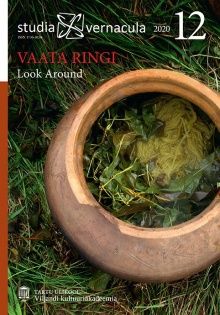Kahesugune tunnetus / Two kinds of knowledge
DOI:
https://doi.org/10.12697/sv.2020.12.46-59Abstract
In this paper, two kinds of knowledge are compared: disembodied and embodied knowledge. The first is represented by the opening passage of Aristotle’s ‘Metaphysics’ and the second is presented by the ‘Zhuangzi’, a Daoist classic of ancient China, attributed to an eponymous author.
At the beginning of his ‘Metaphysics’, Aristotle argues that the highest knowledge (1) is general; (2) is a knowledge of causes (not only that something is as it is, but also why it is so); (3) can be verbalized and (4) can be taught; (5) and that it requires idle time, scholē, a term that has given rise to our word for ”school”. This understanding has become so obvious in the Western tradition that similar ideas are often expressed by people who have never heard of Aristotle’s text.
In the ‘Zhuangzi’, a contrasting ideal is set up that seems surprising to us and must have been baffling to his contemporaries in ancient China. He suggests that the highest knowledge (1) arises from specific practices and contexts; (2) does not know why it does what it does; (3) can neither be adequately be put into words (4) nor taught to others; and (5) is not associated with idle time but derives from some practical activity.
While this second approach may seem strange, it can easily be understood if we consider the bodily practices and craftsmanship that are the basis of Zhuangzi’s view. If we follow the five points mentioned above, we notice that a skilled dancer or craftsman has an exquisite knowledge of bodily movements, tools, and materials, so that it is not simply a case of a ”particular” practical application as opposed to a ”general” theory, but also something that has its own kind of generality that differs from a theoretician’s generality in not being so explicit. It leaves a lot to the body’s implicit knowledge.
As to the second point, a scientist who follows Aristotelian guidelines moves by elimination and explication. She eliminates the vast majority of factors and varies conditions in order to make the essential variables explicit. A craftsman or dancer, on the other hand, moves by extension and implication. She includes more and more factors in her art, more and more situational nuances (a certain kind of timber, room, season, the other people who participate in the performance, etc.). She cannot bring out a single ”cause” of her art, because, in the final analysis, the whole universe or the ”Way” (i.e. the becoming of all things) is implied in her art.
Also, it is not the case that the bodily practitioner is unable to speak or to teach, but her way of speaking and teaching are different from relatively disembodied theoretical realms. Once again, her way of speaking and teaching involves an art of implication, the precise meaning of which remains obscure for someone who has no experience in the art (e.g. when a tin smith teaches how a hammer should be handled: ”Learn from drummers!”). It also has an indelible temporality: while in principle it is possible to instantly grasp a mathematical theorem, it is not possible to skip the essential steps involved in the study of a craft and thus artificially shorten one’s studies.
As far as idleness is concerned, Zhuangzi’s craftsmen and body artists present a twofold challenge. On the one hand, they are not idle but involved in a practice that may have some direct utility (such as a carpenter or a butcher). On the other hand, they suggest that an Aristotelian theoretician is not idle enough, because while she may have freed herself from physical labour, she has enslaved herself to psychic or mental labour. A Zhuangzian master ”wanders freely” in her mind too, without being attached to any theoretical or mental construct, or even to the form of the theoretical or mental itself.
In conclusion, the embodied ideal of knowledge presented by Zhuangzi is not simply a practical counterpart to the theoretical approach, but a completely different kind of attitude with its own rationale that involves an art of implication, nuance, and the thawing of actualized forms of knowledge.
Keywords: embodied cognition, theory, practice, Aristotle, Zhuangzi

